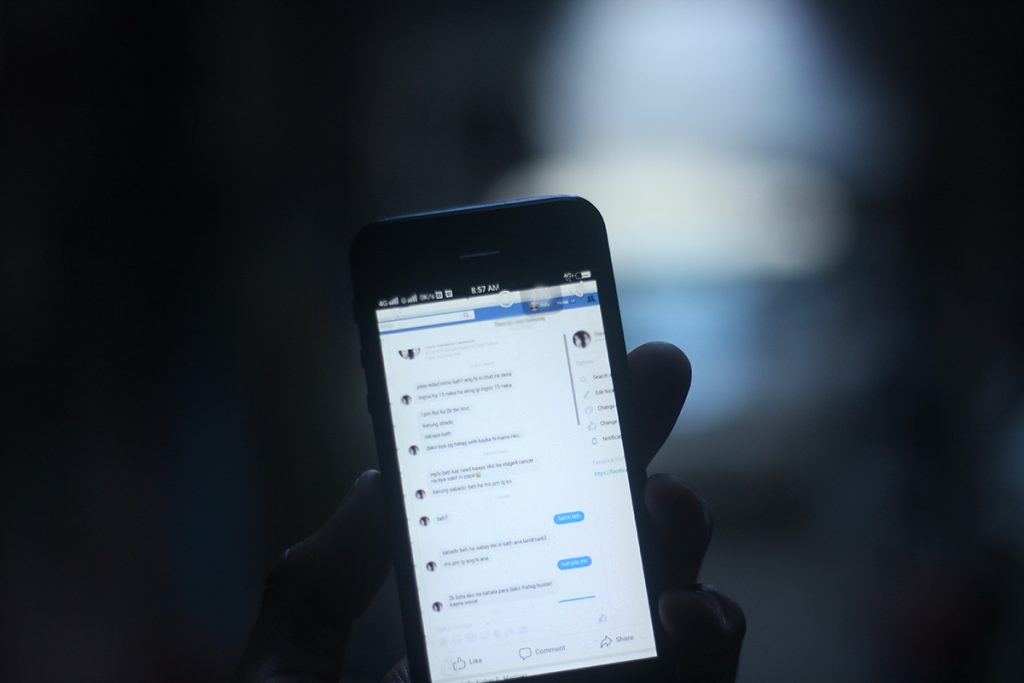
davaotoday.com file photo
DAVAO CITY, Philippines — What started as a friendly exchange of messages over the social media app, Instagram (IG), had turned traumatic for 16-year old Helen (real name withheld to protect her identity).
Helen, in an interview with Davao Today, narrated how a random guy in IG messaged and befriended her. As days passed, the casual chats turned into something serious, with the guy showing romantic interest in her.
She appreciated this virtual friend’s concern towards her when she started sharing about her family, how she and her brother became products of a broken one, and how they were raised by their grandmother instead of their biological parents.
When Helen’s brother got sick and was admitted at the hospital for over a week, “he said he was sorry for what I’ve been going through”.
“We badly needed help for his medication,” Helen said. The guy promised to send P2,000. But only after she sends her nude photos.
In the heart of desperation, Helen clutched on a knife’s blade and sent two topless (from neck down to waist) photos of her. But it didn’t end there. The guy asked for more.
Helen said she has sent a total of seven nudes in exchange for P4,500, which she claimed through a local remittance center. But, she had enough. She decided to block the guy and deleted her own IG account.
Talikala, a non-government organization, said that women and young children remain the vulnerable target of online sexual abuse and exploitation of children (OSAEC). This as many poor Filipinos would do everything to alleviate their sorry situation.
OSAEC is an online activity where women and young children are asked for nude photos or do a livestream of sexual acts in exchange of money. The perpetrators, both local and foreign, lure their victims through a private message, within group chats or through online gaming apps, said Jeanette Ampog, Talikala’s executive director.
Abusing and exploiting, as Ampog shared, starts with the “grooming” process, where perpetrators usually take advantage of the victim’s innocence to gain trust. Virtual strangers start “grooming” young women and children simply by sending a message or a friend request.
But two years since the pandemic, the number of victims remain unaccountable since OSAEC activities have become easier using social media platforms compared to the typical street prostitution.
“It’s difficult to detect (the number of cases) when we talk about digital or the internet because (OSAEC) has been happening within the victims’ rooms, their homes unlike before where it happens in the internet cafes, piso wifis,” she explained.
The shift
Some pimps have even shifted to online bookings as it is easier than making money on the streets.
Pimps are those who control prostituted men and women, arrange clients for the latter and take part of their earnings in return.
Girly (not her real name), 18, was recruited by a neighbor through a Facebook (FB) chat. The latter served as a go-between for a costumer who was looking for a “virgin”.
“During the lockdown, she messaged me if I wanted an extra income. I asked how and she said I will model for a soap (brand), but I need to send sexy photos for the customers,” she shared to Davao Today.
Later on, the said neighbor confessed and told her that customers are looking for virgin females. To entice them, Girly, who was then a minor, had to provide sexy photos. She can discuss the deal with the customer via chat until they reach a certain agreement.
Because she has no income during the lockdown, Girly was compelled and sent a topless photo to her supposed first client. The agreed fee was P2,500 to be sent via GCash. But the fund transfer never happened.
Ampog said OSAEC victims are unaware that leaving their digital footprints online make them more vulnerable to sexual attacks. While the victims only want to earn to sustain their own or their family’s needs, their unprotected exposure to the internet puts them in a very dangerous situation.
Call to action
In Davao City, Talikala has been helping around 25 OSAEC victims. But she said data on these cases will only be counted by the government once the victim decides to file a case in court.
In the three districts, Talikala identified the poor villages of District 1 with the highest number of monitored OSAEC cases.
Since 2014, the Regional Prosecution Office in Davao Region recorded four OSAEC cases involving seven children ages two to 16 while the most recent case, in 2019, involved a mother and her son.
In a report by Sunstar Davao, lawyer Barbara Flores, deputy prosecutor of the Regional Police Office, said “the seven victims were related to each other – either as cousins or siblings” who were exploited by their own mother and two other family members.
While Talikala had been facilitating these cases, Ampog said there has to be done to strengthen efforts especially when it comes to enforcement and child protection. The Davao Region has already formed a task force against OSAEC, but Ampog stressed the need to actively update the efforts in the barangay level.
The group reiterated the call to revisit the enforcement and programs under the barangay levels through the Barangay Child Protect Council and enact specific law against OSAEC exploiters both in local and national government.
In the absence of this law, Ampog said the government should enforce accountability under Republic Act 9208 or the Anti-Trafficking in Persons Act of 2003, as amended by RA 10364 also known as the Expanded Anti-Trafficking in Persons Act of 2012. (davaotoday.com)










